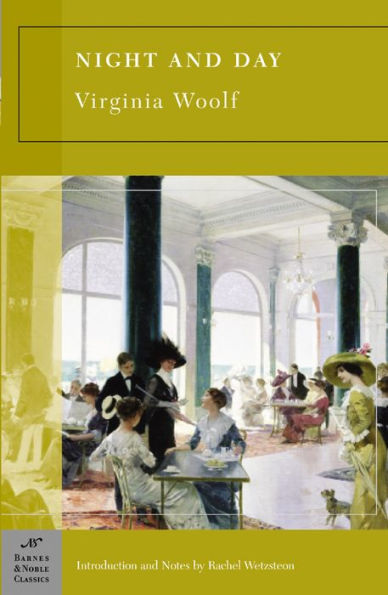Read an Excerpt
From Rachel Wetzsteon’s Introduction to Night and Day
For even the most ardent devotee of modern literature, the title Night and Day is likely to bring to mind Fred Astaire professing undying love—courtesy of Cole Porter—to Ginger Rogers in the 1934 film The Gay Divorcee, rather than Virginia Woolf’s novel, her second, published in 1919. Since the book appeared, it has been the frequent target of mockery, scorn, and incomprehension—if people have paid attention to it at all. Shortly after its publication, fellow novelist Katherine Mansfield criticized the book’s “aloofness” and “air of quiet perfection,” lamented its indifference to the Great War, and incredulously exclaimed, “a novel in the tradition of the English novel . . . we had never thought to look upon its like again!” Woolf’s friend E. M. Forster wrote of the “normalised and dulled” style of the novel in his short book about her, published a year after her death. Critic D. S. Savage found it the “dullest novel in the English language.” And Woolf herself called it “interminable” and marveled in a 1938 letter to her friend Ottoline Morrell, “I can’t believe any human being can get through Night and Day.”
It is true that readers opening the book expecting the stylistic fireworks and structural innovations of Woolf’s later novels like Mrs. Dalloway (1925), To the Lighthouse (1927), and The Waves (1931) will be sorely disappointed. For at first glance, the plot of Night and Day—a young woman choosing between two suitors—is indeed simple and old-fashioned, the very sort of thing Woolf would take to task in her essays on modern fiction, and its lucid, straightforward style offers only the slenderest hints of what would follow.
So why read Night and Day? Although it is among the most consistently neglected of modern novels, it is also one of the most sadly underrated; and readers willing to set aside their expectations for a “typical” Woolf novel will be rewarded in an almost embarrassing variety of ways. They will see Woolf transfiguring people and events from her own life—her family, her marriage, her involvement in the struggle for women’s equality—into vibrant and compelling fictional form. They will watch as she turns, as Jane Austen had done before her, the “universal truth” that young women need husbands from a stale plot device into an uncertain proposition to be undermined from within. They will take pleasure in her wickedly satirical wit and her vivid descriptions of London crowds, the English countryside, and the burning political issues of the day. They will wait in suspense as she searches for a sustainable modern love, a way for women to possess both husbands and independence. And they will enjoy some of the most richly complex and intriguing characters she ever created.
When Woolf began writing Night and Day in late 1914 or early 1915, she had already published one novel, The Voyage Out (1915), as well as many essays and reviews. But she had been ill for several years, and had succumbed to a major breakdown in the first months of 1915. Work offered her a new kind of “voyage out”; as she poignantly admitted in 1930 to her friend Ethel Smyth, she started a new novel largely to keep herself healthy and distracted:
I was so tremblingly afraid of my own insanity that I wrote Night and Day mainly to prove to my own satisfaction that I could keep entirely off that dangerous ground. I wrote it, lying in bed, allowed to write only for one half hour a day (
The Letters of Virginia Woolf, vol. 4, p. 231; see “For Further Reading”).
Initially Woolf intended the novel to be a sweeping study of three generations—the great Victorian poet Richard Alardyce, his daughter Mrs. Hilbery, and her daughter Katharine—but she soon decided to focus more closely on Katharine, her relationship to her family and her courtship by two very different men. Despite a major relapse in February 1916, and her fear (as she confessed to her friend Lytton Strachey) “of finishing a book on this method—I write one sentence—the clock strikes—Leonard appears with a glass of milk,” she made steady progress on the manuscript, and by March 1917 she was “well past 100,000 words.” Night and Day was finished in late 1918 and published by Duckworth the following October.
The novel’s heroine, Katharine Hilbery, has much in common with Woolf, particularly her upbringing in an exceedingly literary household. Woolf’s father, Sir Leslie Stephen (1832–1904), was one of the most distinguished men of letters of the Victorian era, the first editor of the vastly influential Dictionary of National Biography, and the frequent host, at the Stephens’ Kensington residence, to a galaxy of some of the brightest stars in the British cultural firmament. Katharine’s grandfather Richard Alardyce—on whose biography Katharine and her mother labor throughout the novel—is a Victorian of comparable eminence, and the Hilbery house, as the first chapter reveals, remains a place where writers and artists come together for conversation and refreshment. Mr. Hilbery’s literary bent—he edits the fictitious Critical Review—gives him a certain resemblance to Leslie Stephen, but the force of Alardyce’s legacy makes him a closer fictional equivalent.










